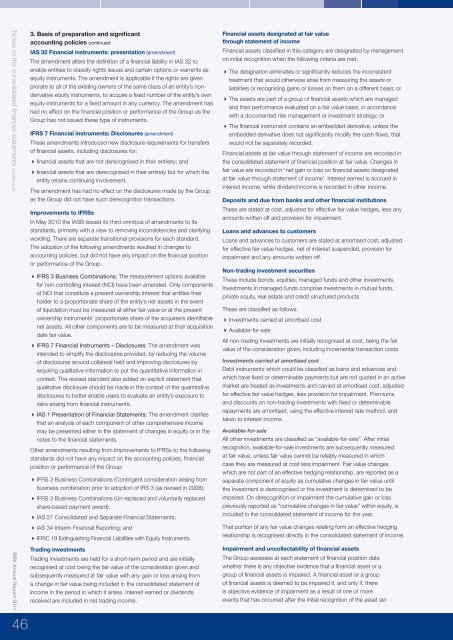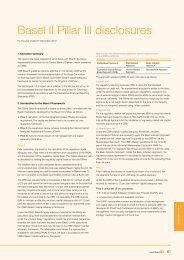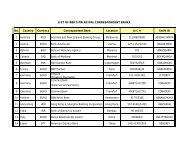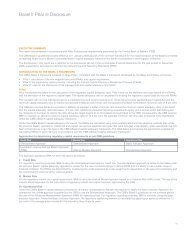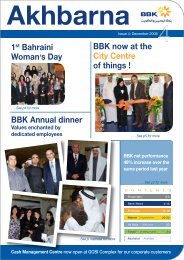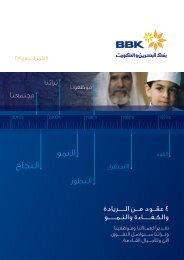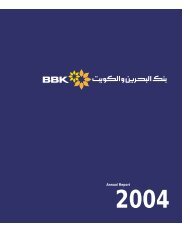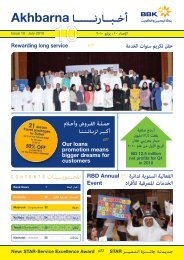31 December <strong>2011</strong>Notes to the consolidated financial statements contineud3. Basis of preparation and significantaccounting policies continuedIAS 32 Financial instruments: presentation (amendment)The amendment alters the definition of a financial liability in IAS 32 toenable entities to classify rights issues and certain options or warrants asequity instruments. The amendment is applicable if the rights are givenprorate to all of the existing owners of the same class of an entity’s nonderivativeequity instruments, to acquire a fixed number of the entity’s ownequity instruments for a fixed amount in any currency. The amendment hashad no effect on the financial position or performance of the Group as theGroup has not issued these type of instruments.IFRS 7 Financial instruments: Disclosures (amendment)These amendments introduced new disclosure requirements for transfersof financial assets, including disclosures for:financial assets that are not derecognised in their entirety; andfinancial assets that are derecognised in their entirety but for which theentity retains continuing involvement.The amendment has had no effect on the disclosures made by the Groupas the Group did not have such derecognition transactions.Improvements to IFRSsIn May 2010 the IASB issued its third omnibus of amendments to itsstandards, primarily with a view to removing inconsistencies and clarifyingwording. There are separate transitional provisions for each standard.The adoption of the following amendments resulted in changes toaccounting policies, but did not have any impact on the financial positionor performance of the Group.IFRS 3 Business Combinations: The measurement options availablefor non-controlling interest (NCI) have been amended. Only componentsof NCI that constitute a present ownership interest that entitles theirholder to a proportionate share of the entity’s net assets in the eventof liquidation must be measured at either fair value or at the presentownership instruments’ proportionate share of the acquiree’s identifiablenet assets. All other components are to be measured at their acquisitiondate fair value.IFRS 7 Financial Instruments – Disclosures: The amendment wasintended to simplify the disclosures provided, by reducing the volumeof disclosures around collateral held and improving disclosures byrequiring qualitative information to put the quantitative information incontext. The revised standard also added an explicit statement thatqualitative disclosure should be made in the context of the quantitativedisclosures to better enable users to evaluate an entity’s exposure torisks arising from financial instruments.IAS 1 Presentation of Financial Statements: The amendment clarifiesthat an analysis of each component of other comprehensive incomemay be presented either in the statement of changes in equity or in thenotes to the financial statements.Other amendments resulting from Improvements to IFRSs to the followingstandards did not have any impact on the accounting policies, financialposition or performance of the Group:IFRS 3 Business Combinations (Contingent consideration arising frombusiness combination prior to adoption of IRS 3 (as revised in 2008);IFRS 3 Business Combinations (Un-replaced and voluntarily replacedshare-based payment award);IAS 27 Consolidated and Separate Financial Statements;IAS 34 Interim Financial <strong>Report</strong>ing; andIFRIC 19 Extinguishing Financial Liabilities with Equity Instruments.Financial assets designated at fair valuethrough statement of incomeFinancial assets classified in this category are designated by managementon initial recognition when the following criteria are met:The designation eliminates or significantly reduces the inconsistenttreatment that would otherwise arise from measuring the assets orliabilities or recognising gains or losses on them on a different basis; orThe assets are part of a group of financial assets which are managedand their performance evaluated on a fair value basis, in accordancewith a documented risk management or investment strategy; orThe financial instrument contains an embedded derivative, unless theembedded derivative does not significantly modify the cash flows, thatwould not be separately recorded.Financial assets at fair value through statement of income are recorded inthe consolidated statement of financial position at fair value. Changes infair value are recorded in ‘net gain or loss on financial assets designatedat fair value through statement of income’. Interest earned is accrued ininterest income, while dividend income is recorded in other income.Deposits and due from banks and other financial institutionsThese are stated at cost, adjusted for effective fair value hedges, less anyamounts written off and provision for impairment.Loans and advances to customersLoans and advances to customers are stated at amortised cost, adjustedfor effective fair value hedges, net of interest suspended, provision forimpairment and any amounts written off.Non-trading investment securitiesThese include bonds, equities, managed funds and other investments.Investments in managed funds comprise investments in mutual funds,private equity, real estate and credit structured products.These are classified as follows:Investments carried at amortised costAvailable-for-saleAll non-trading investments are initially recognised at cost, being the fairvalue of the consideration given, including incremental transaction costs.Investments carried at amortised costDebt instruments which could be classified as loans and advances andwhich have fixed or determinable payments but are not quoted in an activemarket are treated as investments and carried at amortised cost, adjustedfor effective fair value hedges, less provision for impairment. Premiumsand discounts on non-trading investments with fixed or determinablerepayments are amortised, using the effective interest rate method, andtaken to interest income.Available-for-saleAll other investments are classified as “available-for-sale”. After initialrecognition, available-for-sale investments are subsequently measuredat fair value, unless fair value cannot be reliably measured in whichcase they are measured at cost less impairment. Fair value changeswhich are not part of an effective hedging relationship, are reported as aseparate component of equity as cumulative changes in fair value untilthe investment is derecognised or the investment is determined to beimpaired. On derecognition or impairment the cumulative gain or losspreviously reported as “cumulative changes in fair value” within equity, isincluded in the consolidated statement of income for the year.That portion of any fair value changes relating form an effective hedgingrelationship is recognised directly in the consolidated statement of income.<strong>BBK</strong> <strong>Annual</strong> <strong>Report</strong> <strong>2011</strong>46Trading investmentsTrading investments are held for a short-term period and are initiallyrecognised at cost being the fair value of the consideration given andsubsequently measured at fair value with any gain or loss arising froma change in fair value being included in the consolidated statement ofincome in the period in which it arises. Interest earned or dividendsreceived are included in net trading income.Impairment and uncollectability of financial assetsThe Group assesses at each statement of financial position datewhether there is any objective evidence that a financial asset or agroup of financial assets is impaired. A financial asset or a groupof financial assets is deemed to be impaired if, and only if, thereis objective evidence of impairment as a result of one or moreevents that has occurred after the initial recognition of the asset (an
31 December <strong>2011</strong>incurred loss event) and that loss event (or events) has an impacton the estimated future cash flows of the financial asset or thegroup of the financial assets that can be reliably estimated.Evidence of impairment may include indications that the borrower ora group of borrowers is experiencing significant financial difficulty, theprobability that they will enter bankruptcy or other financial reorganisation,default or delinquency in interest or principal payments and whereobservable data indicates that there is a measurable decrease in theestimated future cash flows, such as changes in arrears or economicconditions that correlate with defaults.(i) Financial assets carried at amortised costFor financial assets carried at amortised cost (such as amounts duefrom banks, loans and advances to customers), the Group first assessesindividually whether objective evidence of impairment exists individually forfinancial assets that are individually significant, or collectively for financialassets that are not individually significant. If the Group determines thatno objective evidence of impairment exists for an individually assessedfinancial asset, it includes the asset in a group of financial assets withsimilar credit characteristics and collectively assesses them for impairment.Assets that are individually assessed for impairment and for which animpairment loss is, or continues to be, recognised are not included in acollective assessment of impairment.If there is objective evidence that an impairment loss has been incurred,the amount of the loss is measured as the difference between theasset’s carrying amount and the present value of estimated future cashflows (excluding future expected credit losses that have not yet beenincurred). The carrying amount of the asset is reduced through the useof an allowance account and the amount of the loss is recognised inthe consolidated statement of income. Interest income continues to beaccrued on the reduced carrying amount and is accrued using the rateof interest used to discount the future cash flows for the purpose ofmeasuring the impairment loss. The interest income is recorded as part of‘interest income’. Loans together with the associated allowance are writtenoff when there is no realistic prospect of future recovery and all collateralhas been realised or has been transferred to the Group.If, in a subsequent year, the amount of the estimated impairment lossincreases or decreases because of an event occurring after the impairmentwas recognised, the previously recognised impairment loss is increasedor reduced by adjusting the allowance account. If a future write-off is laterrecovered, the recovery is credited to provision for impairment.assumptions used for estimating future cash flows are reviewed regularly toreduce any differences between loss estimates and actual loss experience.(ii) Available-for-sale financial assetsFor available-for-sale investments, the Group assesses at each statementof financial position date whether there is objective evidence that aninvestment is impaired.In the case of debt instruments classified as available-for-sale, the Groupassesses individually whether there is objective evidence of impairmentbased on the same criteria as financial assets carried at amortised cost.However, the amount recorded for impairment is the cumulative losson the investment previously recognised in the consolidated statementof income. Future interest income is based on the reduced carryingamount and is accrued using the rate of interest used to discount thefuture cash flows for the purpose of measuring the impairment loss. Theinterest income is recorded as part of interest. If in a subsequent period,the fair value of a debt instrument increases and the increase can beobjectively related to a credit event occurring after the impairment loss wasrecognised in the consolidated statement of income, the impairment lossis reversed through the consolidated statement of income.In the case of equity investments classified as available-for-sale, objectiveevidence would also include a ‘significant’ or ‘prolonged’ decline in thefair value of the investment below its cost. Where there is evidence ofimpairment the cumulative loss measured as the difference between theacquisition cost and the current fair value, less any impairment loss on thatinvestment previously recognised in the consolidated statement of incomeis removed from equity and recognised in the consolidated statementof income. Impairment losses on equity investments are not reversedthrough the consolidated statement of income. Increases in fair value afterimpairment are recognised directly in equity.(iii) Renegotiated loansWhere possible, the Group seeks to restructure loans rather than totake possession of collateral. This may involve extending the paymentarrangements and the agreement of new loan conditions. Once the termshave been renegotiated any impairment is measured using the originaleffective interest rate as calculated before the modification of terms andthe loan is no longer considered past due. Management continuouslyreviews renegotiated loans to ensure that all criteria are met and thatfuture payments are likely to occur. The loans continue to be subject to anindividual or collective impairment assessment, calculated using the loan’soriginal effective interest rate.Notes to the consolidated financial statements contineudThe present value of estimated future cash flows is discounted at thefinancial asset’s original effective interest rate. If a loan has a variableinterest rate, the discount rate for measuring any impairment loss is thecurrent effective interest rate. The calculation of the present value of theestimated future cash flows of a collateralised financial asset reflects thecash flows that may result from foreclosure less costs for obtaining andselling the collateral, whether or not foreclosure is probable.For the purpose of a collective evaluation of impairment, financial assetsare grouped on the basis of the Group’s internal credit grading system,that considers Credit Risk characteristics such as asset type, industry,geographical location, collateral type, past due status and other relevantfactors.Term borrowingsFinancial instruments or their components issued by the Group, which arenot designated at fair value through statement of income, are classified asliabilities under ‘term borrowings’, where the substance of the contractualarrangement results in the Group having an obligation either to delivercash or another financial asset to the holder, or to satisfy the obligationother than by the exchange of a fixed amount of cash or another financialasset for a fixed number of own equity shares.After initial measurement, term borrowings are subsequently measuredat amortised cost using the effective interest rate. Amortised cost iscalculated by taking into account any discount or premium on the issueand costs that are an integral part of the effective interest rate.Future cash flows on a group of financial assets that are collectivelyevaluated for impairment are estimated on the basis of historical lossexperience for assets with Credit Risk characteristics such as asset type,industry, geographical location, collateral type, past due status and otherrelevant factors.Future cash flows on a group of financial assets that are collectivelyevaluated for impairment are estimated on the basis of historical lossexperience for assets with Credit Risk characteristics similar to those inthe group. Historical loss experience is adjusted on the basis of currentobservable data to reflect the effects of current conditions on which thehistorical loss experience is based and to remove the effects of conditionsin the historical period that do not exist currently. The methodology andDerecognition of financial assets and financial liabilitiesFinancial assetsA financial asset (in whole or in part) is derecognised where:The rights to receive cash flows from the asset have expired; The Group has transferred its rights to receive cash flows from theasset or has assumed an obligation to pay the received cash flowsin full without material delay to a third party under a ‘pass-through’arrangement; and either (a) the Group has transferred substantially all therisks and rewards of ownership or (b) when it has neither transferred orretained substantially all the risks and rewards and when it no longer hascontrol over the financial asset, but has transferred control of the asset.<strong>BBK</strong> <strong>Annual</strong> <strong>Report</strong> <strong>2011</strong>47


